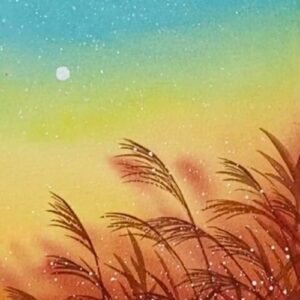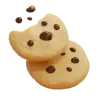Disclosure: This post contains affiliate links, meaning if you make a purchase via the links, we will earn a commission at no additional cost to you. Please read the full disclosure.

Ah, the captivating beauty of a reed sunset! Imagine capturing the vibrant hues of the sky as it dances with the gentle swaying of the reeds. In this watercolor tutorial, I’ll guide you through the process of creating your very own masterpiece, one brushstroke at a time.
Step-by-step watercolor tutorial for painting a reed sunset
First, let’s gather our essential supplies:
- Watercolor paper (cold-pressed or rough surface)
- Watercolor paints (warm tones like reds, oranges, and yellows)
- Brushes (round and flat brushes in various sizes)
- Water container
- Paper towels
Now, let’s begin our artistic journey!

Step 1
Sketch the Composition: Start by lightly sketching the outline of the reeds on your watercolor paper. Leave ample space for the sky and horizon line.

Step 2
Wet the Paper: Using a clean brush, wet the whole paper where you'll paint the sunset sky. This will help the colors blend seamlessly.

Step 3
Paint the Sky: Start with a vibrant blue hue at the top of the paper, gradually transitioning to yellow, oranges and reds as you move downward.

Step 4
Continue to blend the color: Allow the colors to blend naturally, creating a stunning sunset effect.

Step 5
Add the Reeds: While the paper is still wet, use a round brush to paint the reeds with varying shades of red and browns.

Step 6
Dry the paper: Wait for the paper get fully dried.

Step 7
Paint reeds details: Once the paper is dry, paint more reeds. Pay attention to the details, such as the delicate blades and their reflections on the water.

Step 8
Enhance with details: Paint the details with a relaxed hand. It is important to keep the reeds looking loosely.

Step 9
Add texture to the reeds: Add different shapes of leaves to the reeds .

Step 10
Enhance with Details: Add depth to your painting by incorporating shadows, highlights, and reflections. Use a smaller brush to create intricate details, such as a moon in the sky or subtle highlights on the reeds.
Exploring different watercolor painting styles
While the reed sunset tutorial showcases a realistic approach, the world of watercolor painting offers a vast array of styles to explore. Each style brings its own unique charm and allows you to express your artistic vision in captivating ways.
Loose and Expressive: Embrace the fluidity of watercolors by letting the paint flow freely on the paper. This style celebrates spontaneity and allows for bold, expressive brushstrokes that capture the essence of your subject matter.
Wet-on-Wet Technique: This technique involves painting on a pre-wetted surface, allowing the colors to blend and create stunning, organic effects. It’s perfect for capturing the ethereal beauty of landscapes or abstract compositions.
Layering and Glazing: By applying multiple layers of transparent watercolor washes, you can create depth and luminosity in your paintings. This technique is particularly effective for portraying intricate details and achieving a sense of realism.
Negative Painting: Instead of painting the subject directly, this style focuses on painting around the subject, leaving the desired shape untouched. It’s a unique approach that can add a sense of mystery and intrigue to your artwork.
Experiment with these styles and find the one that resonates with your artistic vision. Remember, there are no rules in watercolor painting – embrace the freedom and let your creativity soar!
Tips for creating beautiful watercolor flower paintings
Flowers are a popular subject matter in watercolor painting, and for good reason. Their delicate petals, vibrant colors, and intricate details make them a captivating subject to capture on paper. Here are some tips to help you create stunning watercolor flower paintings:
Study the Subject: Before you begin painting, take the time to observe the flower closely. Notice the shapes, colors, and textures of the petals, stems, and leaves. This attention to detail will help you capture the essence of the flower in your painting.
Start with a Loose Sketch: Begin with a loose pencil sketch to establish the overall composition and placement of the flower on the paper. This will serve as a guide for your watercolor painting.
Wet the Paper: Lightly mist or wet the paper before applying the first layer of paint. This will help the colors blend seamlessly and create a soft, natural effect.
Layer and Glaze: Build up the colors and details of the flower by layering and glazing. Start with lighter washes and gradually add darker tones to create depth and dimension.
Embrace Negative Painting: Utilize the negative painting technique to create crisp edges and define the shapes of the petals and leaves. This can add a sense of depth and dimension to your flower painting.
Add Texture and Details: Once the base layers are dry, use a smaller brush to add texture and intricate details to the flower. This could include veins on the petals, subtle highlights, or delicate shadows.
Remember, watercolor flower paintings are all about capturing the delicate beauty and natural essence of the subject. Take your time, observe closely, and let your brushstrokes dance across the paper, bringing your floral masterpiece to life.
Embrace the vibrant world of watercolor painting
As we come to the end of our watercolor journey, I hope you feel inspired and empowered to embrace the vibrant world of watercolor painting. This medium offers endless possibilities for creativity, self-expression, and the capture of nature’s beauty.
Whether you’re painting a reed sunset, a delicate flower, or an abstract composition, remember to let your brushstrokes flow freely and embrace the unpredictable nature of watercolors. Each painting is a unique adventure, a dance between color, water, and your artistic vision.
So, gather your supplies, unleash your creativity, and let the magic of watercolor painting unfold before your eyes. Remember, practice makes progress, and every stroke is a step towards mastering this captivating medium.















